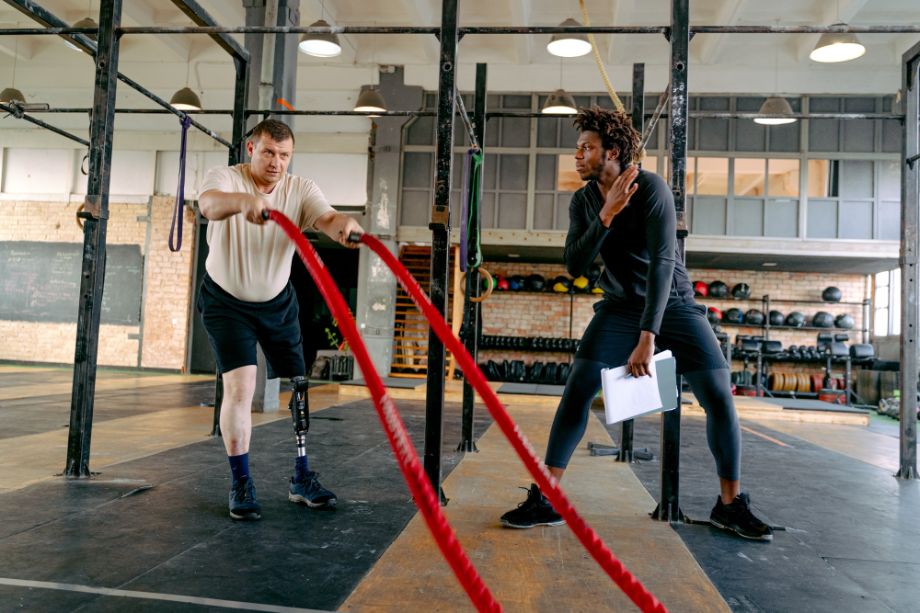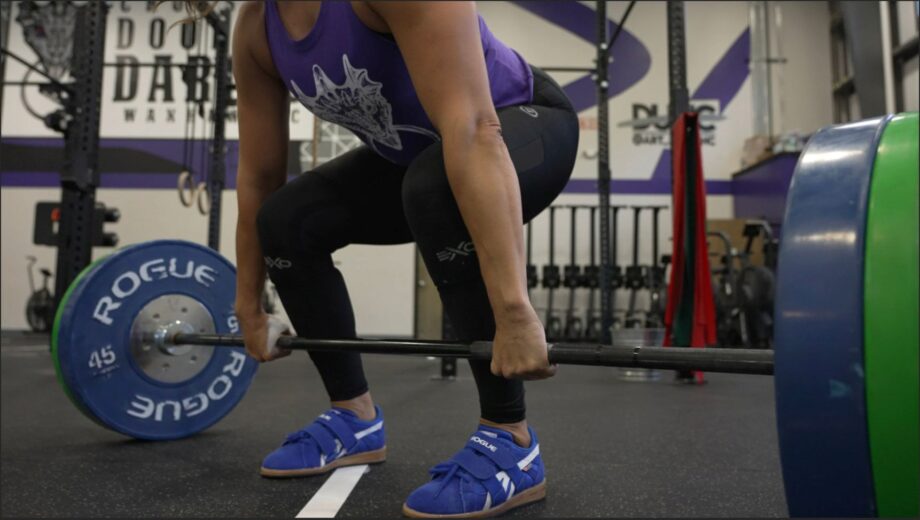Battle ropes have become a staple of gyms worldwide. The low-impact training that battle ropes offer provides an efficient and fun way to burn fat, build strength, and get an intense cardiovascular workout.
Whether you are sitting down or standing up, battle ropes simultaneously engage you in cardio and strength training without the issues of lugging around weights or exerting problematic stress on your knees. Furthermore, battle ropes are quite affordable from places like Amazon and easy to set up and store, making them a perfect home gym accessory.
In this article, we want to share some great battle rope exercises to help you get an excellent full-body battle rope workout.
3 Tips For Using Battle Ropes Properly
Like any exercise, proper technique can help to ensure the best results!
1. Keep Proper Tension on the Ropes
A lack of slack or too much rope tension can deter your battle rope training’s fluidity and benefits.
To calculate the distance of your stance and rope slack, start by holding the grips at the end of the ropes at a distance from the anchor where you feel a slight tension begin. Next, hold the ropes at your sides, then step forward until your toes meet the ropes on the ground. From there, you should have a quality slack and the correct distance to best engage the ropes.
2. Use the Anchor as a Guide
Use your battle rope’s anchor point as a target to guide your stance and placement. Squaring off to the anchor or center point of your battle ropes can help you to correctly reset if you lose balance or find the best standing position to maintain a level rope movement.
3. Maintain the Right Form
When standing up and grasping the ropes, ensure a firm upper- and lower-body position. The ideal stance is your feet firmly placed hip-width apart, with a slight bend in your knees (resembling a quarter squat), raised chest, and toes pointing forward. Your spine should feel neutral, while your core should feel fully activated when creating the rope’s movements.
If you feel stress in your back, which often comes from compensating for a neglected core, you should reset to ensure you are in a proper stance where your core is adequately engaged.

15 Battle Rope Exercises and How to Do Them
Here are some excellent battle rope exercises to do on their own or incorporate into your broader workout!
1. Battle Rope Double Waves
How to Do It:
First, grasp each end of the rope at shoulders-width apart in a firm standing battle rope position. Then, begin alternating arms to move your battle ropes up and down, creating alternating wave movements in the ropes as you lower one and raise the other.
2. Battle Rope Waves
How to Do It:
Hold the ropes at shoulder-width apart in a slightly squatted position. Then, while engaging your shoulders and core, begin to explosively raise and lower the ropes with both of your arms simultaneously moving up and down at the same time. The ropes should rise and slam down to the ground in a synchronized pattern.
3. Shuffling Double Waves
How to Do It:
Engage in the double wave technique, and begin to shuffle side-to-side while maintaining the rope’s waves. When shuffling, use the rope’s anchor as a centering guideline for how to keep a balanced distance of your shuffle movements.
4. Back-and-Forth Double Waves
How to Do It:
When engaged in a double wave, delicately walk forward and backward, maintaining a steady movement of the ropes and a firm quarter-squat stance. Take enough steps forward (four to eight is typical) to complicate the workout yet not disrupt steady rope waves, then walk back to your original standing position and slack.
5. Battle Rope Jumping Jacks
How to Do It:
While standing, ensure a firm grip on the ropes and enough slack to conduct a jumping jack. Begin doing jumping jacks while holding the battle ropes, raising them up and down as you move.
6. Rope Claps
How to Do It:
With the rope’s grips tightly grasped, chest raised, and knees slightly bent in a quarter-squat position, move your arms to the side and back to the center to make the ropes clap in the air. Continue by slapping the ropes where they meet, then separate them immediately. Try to increase the length of the clap and keep the ropes at a consistently elevated level.
7. One-Armed Plank Waves
How to Do It:
Place yourself at the center of your ropes, facing forward towards the rope’s anchor. Get into an up or “push-up” plank position with your left arm inside the left rope. Grab the right rope with your right hand, and begin raising and lowering the rope to create a wave movement while maintaining your plank position. Switch to your other arm using the same method.
8. One-Armed Side Plank Waves
How to Do It:
Get into a right-side plank so that your right forearm and elbow are positioned parallel to the inside of the right rope on the ground. Then, while in a side plank, use your elevated arm to grab the left rope with your left hand and raise and lower the rope to create a wave movement while maintaining your side plank position. Then, switch to your left side using the same method.
9. Battle Rope Burpees
How to Do It:
Incorporate the battle rope into a burpee. To do this, grasp the handles and pull the ropes above your head while you jump and slam them down as you land on the ground to engage in a push-up before repeating. The rope should make a single-wave movement as you jump up and come down.
10. Cyclones
How to Do It:
While in your quarter-squat battle rope position, twist the battle ropes using both arms to create a fluid cyclone-like circle movement as the rope moves. Turn the ropes clockwise for your determined set time, then repeat going counterclockwise, or vice versa.
11. Cyclone Walks
How to Do It:
When engaged in the cyclone battle rope exercise, start to move forward and backward four to eight steps while maintaining your quarter squat stance and the rope’s cyclone movement. When walking forward, twist the ropes clockwise; when walking backward, counterclockwise (or however you prefer). Be mindful of excess slack when walking forward and tension in the ropes created when walking back. The goal is to maintain a consistent and fluid cyclone as you move the whole time.
12. Snakes
How to Do It:
While properly squared off to the anchor and in your starting battle rope position, lower your arms holding the battle rope slightly above your knees. Make sure your arms are extended, and your back is not strained. From there, move the ropes side to side with explosive power, keeping your arms stretched and utilizing your core strength for more intensity. You should see an “S” or snake-like movement by the ropes on the ground.
13. Outer and Inner Circles
How to Do It:
When in your starting stand-up battle rope position, use your grip to create an outer circular movement in the ropes. Do this by swinging each rope in a large and continuous circular motion where the ropes go opposite directions, ensuring full extension and power in each rotation. Then, reverse or follow up your outer circles with inner circles that go in the opposite direction but are done using the same logic.
14. Jump Squat Rope Slams
How to Do It:
Starting from your proper quarter squat position, hold the ropes firmly in each hand, shoulder-width apart. Then, start your jumping squats, incorporating the ropes by swinging them above your head as you jump and slamming the ropes down as you land in your fully squatted position.
15. Russian Twist Waves
How to Do It:
Incorporate the rope into your Russian twists the way you would a kettlebell or dumbbell. Start by holding the rope’s grips together, then create a wave in the rope over your knees as you move from side to side. As the grips come close to the ground in your twist, promptly return to the other side to keep the wave movement active, trying to prevent rope slack from touching your knees. Keep a firm grasp on the rope’s grips, but get your power from your core’s movements.
Try This: Full-Body Cardio Battle Rope Workout
Here is an excellent high-intensity interval training battle rope workout that will get your heart rate up and muscles burning!

Three to five sets:
- 30 battle rope jumping jacks
- 30-second break
- 10 battle rope burpees
- 30-second break
- 30 seconds of double waves
- 15-second break
- 30 seconds of waves
- 15-second break
- 30 seconds of clockwise cyclone
- 15-second break
- 30 seconds of counterclockwise cyclone
- 15-second break
Decrease or increase the time and reps according to your fitness level and battle rope experience. Make sure to push yourself harder with each round, always ending with an intense finisher. And don’t forget to do your best to maintain proper stance and technique with each exercise, always seeking quality over quantity!
Battle Rope Workout: Q&A
How long should a battle rope workout be?
There is no set time frame for the perfect battle rope routine. This depends on your fitness level and whether or not you are incorporating your rope exercises into a broader workout regimen.
I suggest diving in for at least a 15-minute intense rope workout if you plan to train with ropes alone. By mapping out your workout and your breaks in advance, you can get a lot out of battle ropes in just 15 minutes of proper use.
Are battling ropes a good workout?
Battle ropes offer a great workout. Like CrossFit, battle ropes uniquely offer a cardio and strength-building total body workout simultaneously. In addition, battle ropes work your whole lower and upper body despite being a low-impact exercise for your joints.
Are battle ropes good for losing belly fat?
Battle ropes can be an excellent tool for burning fat. Some battle rope exercises offer an intense cardio workout, which can help to speed up your metabolism, burn calories, and enable fat loss.
In addition, many of the benefits of battle ropes are best experienced when your core is fully activated in your movement of the ropes. Because of this, in addition to burning fat, battle rope exercises can help to tone your belly and replace lost fat with lean muscle.
Do battle ropes build muscle?
Battle ropes can help build muscle. Battle ropes offer a chance at a HIIT workout that blends cardio with strength. For example, a heavy rope’s weight alone adds muscle-building elements to every exercise you do with them (consider jumping jacks on their own versus battle rope jumping jacks).
Furthermore, increasing time or reps as you advance during your battle rope exercises can help ensure gains in full body strength over time. However, like any exercise, gains and results are best achieved parallel to a healthy and protein-rich diet.







